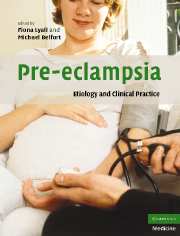Book contents
- Frontmatter
- Contents
- List of contributors
- Preface
- Part I Basic science
- Part II Clinical Practice
- 17 Classification and diagnosis of pre-eclampsia
- 18 Measuring blood pressure in pregnancy and pre-eclampsia
- 19 Immune maladaptation in the etiology of pre-eclampsia; an updated epidemiological perspective
- 20 Genetics of pre-eclampsia and counseling the patient who developed pre-eclampsia
- 21 Thrombophilias and pre-eclampsia
- 22 Medical illness and the risk of pre-eclampsia
- 23 The kidney and pre-eclampsia
- 24 Management of mild pre-eclampsia
- 25 Management of severe pre-eclampsia
- 26 The differential diagnosis of pre-eclampsia and eclampsia
- 27 Complications of pre-eclampsia
- 28 Central nervous system findings in pre-eclampsia and eclampsia
- 29 Pathogenesis and treatment of eclampsia
- 30 Anesthesia for the pre-eclamptic patient
- 31 Critical care management of severe pre-eclampsia
- 32 The role of maternal and fetal Doppler in pre-eclampsia
- 33 Pregnancy-induced hypertension – the effects on the newborn
- 34 Medico-legal implications of the diagnosis of pre-eclampsia
- Subject index
- References
30 - Anesthesia for the pre-eclamptic patient
from Part II - Clinical Practice
Published online by Cambridge University Press: 03 September 2009
- Frontmatter
- Contents
- List of contributors
- Preface
- Part I Basic science
- Part II Clinical Practice
- 17 Classification and diagnosis of pre-eclampsia
- 18 Measuring blood pressure in pregnancy and pre-eclampsia
- 19 Immune maladaptation in the etiology of pre-eclampsia; an updated epidemiological perspective
- 20 Genetics of pre-eclampsia and counseling the patient who developed pre-eclampsia
- 21 Thrombophilias and pre-eclampsia
- 22 Medical illness and the risk of pre-eclampsia
- 23 The kidney and pre-eclampsia
- 24 Management of mild pre-eclampsia
- 25 Management of severe pre-eclampsia
- 26 The differential diagnosis of pre-eclampsia and eclampsia
- 27 Complications of pre-eclampsia
- 28 Central nervous system findings in pre-eclampsia and eclampsia
- 29 Pathogenesis and treatment of eclampsia
- 30 Anesthesia for the pre-eclamptic patient
- 31 Critical care management of severe pre-eclampsia
- 32 The role of maternal and fetal Doppler in pre-eclampsia
- 33 Pregnancy-induced hypertension – the effects on the newborn
- 34 Medico-legal implications of the diagnosis of pre-eclampsia
- Subject index
- References
Summary
Hypertensive disease affects roughly 6–8% of all pregnancies and is the second leading cause of maternal morbidity and mortality. It accounts for almost 15% of pregnancy-related maternal deaths, and is a major risk factor for fetal morbidity and mortality (Berg et al., 1996; Longo et al., 2003); there is also a substantial contribution to stillbirths, neonatal morbidity and mortality as a result of premature deliveries.
Terminology and classification
Historically, there have been varied and diverse terminologies used to describe hypertension during pregnancy. Previous terminology such as pregnancy-induced hypertension has been abandoned. The Report of the National High Blood Pressure Education Program Working Group on High Blood Pressure in Pregnancy (2000) has attempted to standardize the classification.
The currently accepted classification is as follows:
pre-eclampsia–eclampsia with or without HELLP (hemolysis, elevated liver enzymes, and low platelet count) syndrome;
pre-eclampsia superimposed on chronic hypertension;
chronic hypertension; and
gestational hypertension.
Pre-eclampsia
Background
Unique to humans, pre-eclampsia is a multiorgan disease of unknown origin. Symptoms present themselves in a normotensive woman after the twentieth week of gestation. However, pre-eclampsia can occur in normotensive patients with trophoblastic disease (e.g. molar pregnancy) prior to the twentieth week (Ness and Roberts, 1996). The risk of developing pre-eclampsia is greater in women with pre-existing conditions such as chronic hypertension, diabetes, antiphospholipid syndrome and collagen vascular disease.
A detailed discussion of the etiology and pathogenesis of pre-eclampsia and eclampsia is beyond the scope of this chapter.
- Type
- Chapter
- Information
- Pre-eclampsiaEtiology and Clinical Practice, pp. 451 - 475Publisher: Cambridge University PressPrint publication year: 2007



